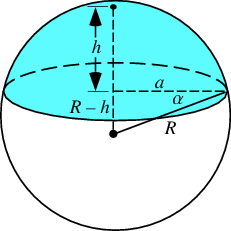I'm trying to calculate the inertia tensor of a spherical cap (a piece of a sphere) like the one shown below.
[![spherical_cap][1]][1]
(from MathWorld - A Wolfram Web Resource: wolfram.com)
The origin (not shown) is located at the center of the whole sphere and the axes oriented as usual: $z$ points upwards, $x$ points out of the page, etc. I'm also asuming constant density.
To calculate the moments I'm using triple integrals. For the inertia moment around the $z$ axis I have:
$$\rho\int_0^{2\pi} \int_{R-h}^R \int_{0}^{\sqrt(R^2-h^2)} r^3 dr dh d\theta$$
Which gives:
$$\frac{mh}{10(3r-h)} (3h^2-15hR+20R^2)$$
Which is correct, I think, because if you replace $h=R$, it is going to give the inertia moment of a hemisphere. The problem is when I move on to the moments around other axes. I have seen on the web that they must be the same, but I need to prove it. For example around $y$ I have the following:
$$\rho\int_0^{2\pi} \int_{R-h}^R \int_{0}^{\sqrt(R^2-h^2)} r^3 \cos^2(\theta) dr dh d\theta$$
Which gives:
$$\frac{mh}{20(3r-h)} (3h^2-15hR+20R^2)$$
Which is half the one around the $z$ axis... What can I be doing wrong? Are the limits of the integrals wrong, but because of luck they give the correct answer for the $z$ axis? [1]: https://i.sstatic.net/24dVD.gif
